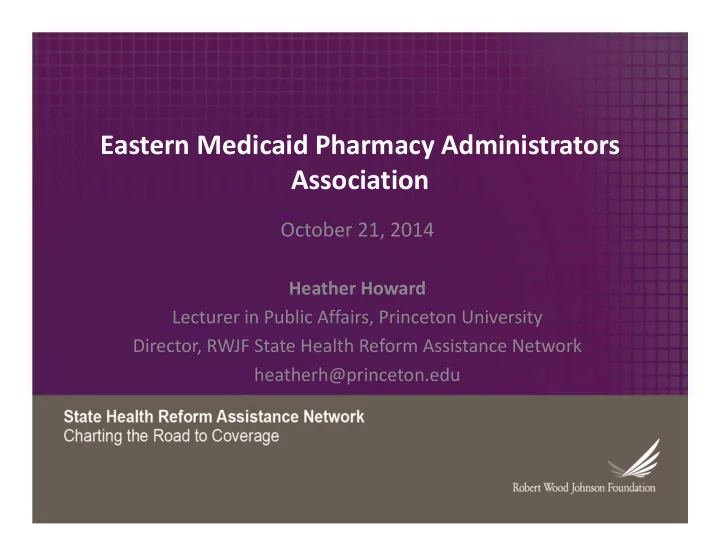

Eastern Medicaid Pharmacy Administrators Association October 21, 2014 Heather Howard Lecturer in Public Affairs, Princeton University Director, RWJF State Health Reform Assistance Network heatherh@princeton.edu
Overview • Current Status of ACA Implementation • Impact of ACA • Issues to Watch
Medicaid Expansion Status
Medicaid Expansion – Current status 28 states (including DC) expanding Medicaid • 5 states expanding Medicaid using an alternative to • traditional expansion. States see opportunity (and leverage) to innovate using • waivers Several considering expansion • Indiana in negotiations with CMS • TN and UT preparing plans • Impact of elections? •
Medicaid Expansion: Alternative Approaches Arkansas “private option” providing QHP premium • assistance to newly eligible adults up to 138% FPL Michigan expansion – creation of health savings accounts, • consumer healthy behavior incentives, premiums and copays, and four year “limit” Pennsylvania alternative recently approved; includes • premiums, but no job search requirement as previously proposed
Medicaid Expansion Challenges • How has expansion decision played out in states? • State analysis of impact • Role of stakeholders • Politics trumps policy in many states • Enrollment • Problems interfacing with healthcare.gov • Expansion enrollments still beat state estimates • “Woodwork effect” even in states that didn’t expand • Provider capacity
Impact of expansion – Distribution of the uninsured
Type of Health Insurance Marketplace
Enrollment numbers Exchange enrollment this year • • Enrollment through August: 7.3 million • Original CBO projection for all of 2014: 7 million Medicaid enrollment • • Approximately 8 million additional individual Medicaid enrollments since October 2013 • States with expanded Medicaid programs experienced 20 percent enrollment growth, compared to 5 percent growth in states that did not expand Medicaid Projections for 2015 • • CBO projects cumulative enrollment of 13 million in the exchanges • CBO projects additional cumulative Medicaid/CHIP enrollment to reach 11 million in 2015
Early Victories and Challenges 47% of all exchange enrollees nationally, and 52% of those • age 18 ‐ 34, enrolled the last month of the initial OEP 80% avoided bronze plans • FFM enrollment grew rapidly once healthcare.gov fixed • Some FFM states putting substantial barriers in the way of • federally funded consumer assisters Some SBM state IT systems still not up to par • • Vendors unable to deliver • States didn’t use systems integrator • Medicaid and exchanges not sufficiently coordinated
Early Observations – Systems Builds • Importance of systems integrator • The vendor matters • Focus on core functionality – avoid scope creep • Integration with Medicaid is key • Focus on consumer experience • Clear lines of accountability, both internally and in vendor contracts
Maslow’s Hierarchy of Needs
Exchange Hierarchy of Goals Enhance Quality of Care, Strengthen Delivery Systems and Improve Population Health Self ‐ Actualization Restrain Premium Trend and other Costs Esteem Near Universal Coverage Belonging Financially Self ‐ Sustaining, Enhanced Consumer Experience and Decision Support Tools Security Accurate and Timely Functionality, Good Customer Service Physiological
What’s changed for OEP2 • Renewals • Shorter enrollment period – Nov. 15 to Feb. 15 • Different shopping experience • More carriers in many states • Premium changes • Impact on subsidies • Increased penalty for not carrying insurance • First year of tax forms (1095s) • Year of experience • Impact on Medicaid?
Renewals • CMS has provided states with great flexibility in the Medicaid renewal (a.k.a. redetermination) process • States can delay renewals • States can use new data sources to process renewals • Marketplace renewals may present challenges for Medicaid • Auto ‐ renewal in FFM states may put a person into a Marketplace plan when they should have been Medicaid • Persons that renew on the Marketplace may be found eligible for Medicaid (perhaps with retroactivity) while they are still enrolled in their QHP • Medicaid should remain payer of last resort • Renewal process will strain consumer assistance and eligibility functions
Issues to Watch • IT Challenges • State Medicaid and Federal Exchange connections • November 2014 election • New Medicaid expansion states / Federal Flexibility • Churn • Health insurance literacy and utilization • Ongoing debates on specialty pharmaceuticals
Heather Howard Director, RWJF State Health Reform Assistance Network Lecturer in Public Affairs, Princeton University Woodrow Wilson School of Public and International Affairs (609) 258 ‐ 9709 heatherh@princeton.edu
Recommend
More recommend